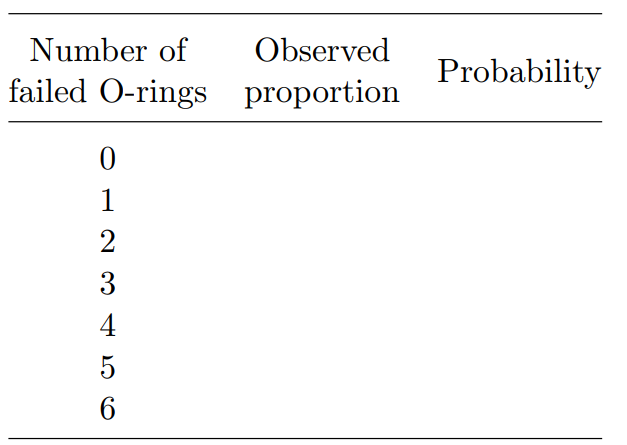The Open University Statistics - M248 TMA02
The Open University Statistics TMA02
Question 1 - 27 marks
You should be able to answer this question after working through Unit 3.
(a) In 1986, the US Space Shuttle Challenger tragically exploded in flight. This accident was caused by the catastrophic failure of rubber ‘O-ring’ seals that linked segments of its rocket boosters together. There were six O-ring seals in Challenger (and all other Space Shuttles at the time). Table 1 shows the numbers of O-ring seal failures that had occurred on each of 23 previous Space Shuttle flights.
Table 1 Number of O-ring seal failures
(i) Let p be the probability that an O-ring seal fails on a flight. What distribution is appropriate to describe the failure or non-failure of a particular O-ring seal on a particular flight? (Ensure that you
define the corresponding random variable appropriately.)
(ii) A reasonable estimate of p is 3=46 ’ 0:065. Explain where this number comes from.
(iii) It is suggested that an appropriate model for the number of O-ringseals that fail on a particular flight might be a binomial distribution B(6; p). What assumptions are made by using thismodel? In your opinion, is a binomial model appropriate? Briefly justify your answer.
iv) Use Minitab to obtain a table containing both the p.m.f. and c.d.f. of the B(6; p) distribution with p = 0:065. (Do not change the number of decimal places of the values obtained from those provided by Minitab.)
(v) Use the information in Table 1 and the solution to part (a)(iv) to complete the following table, giving your values rounded to three decimal places.

Comment briefly on how close the observed proportions of flights on which 0; 1; 2; : : : ; 6 O-ring seals failed are to those predicted by the binomial model. What does this suggest about the appropriateness, or otherwise, of the binomial model?
(b) Records show that 6% of blood samples tested for a certain condition test positive. Assuming that whether or not a blood sample tests positive is independent of whether or not any other blood sample tests
positive, calculate by hand the following probabilities correct to four decimal places. In each case, state clearly the probability model that you use (including the values of any parameters) and show your working.
(i) The probability that, out of 20 samples tested, at least three will test positive. [6]
(ii) The probability that the first blood sample that tests positive tomorrow will be the ninth sample tested. [3]
(c) The number of flaws in a fibre optic cable follows a Poisson distribution with parameter λ = 1:25. Calculate by hand the probability that there are two or fewer flaws in such a fibre optic cable, giving your answer correct to three decimal places. Show your working.
Question Two
You should be able to answer this question after working through Unit 4.
(a) In Question 2(b) of TMA 01, the probability mass function of a discrete random variable X representing the number of bicycles available at a docking station each morning was introduced. This p.m.f. is repeated
here, in Table 2.

(i) What is the mean number of bicycles available at the docking station each morning? [2]
(ii) What is the variance of the number of bicycles available at the docking station each morning?
(b) The Atacama Desert in Chile is known as the driest place on Earth. Suppose that in one part of the Atacama Desert, whether it rains at all in a given year has probability 0.2 and that whether or not it rains in one year is independent of whether or not it rains in any other year.
Answer the following questions, in each case stating clearly the probability model that you use (including the values of any parameters).
(i) Suppose that a random variable X is defined to take the value 1 when there is rainfall in a particular year and 0 when there is not.
What is the mean of the random variable X? [2]
(ii) What is the expected number of years with some rainfall in a period of 100 years? [2]
(iii) What is the expected value of the number of years up to and including the first year in which there is some rainfall? [2
(c) A scout on a camping trip is requested to find some dry sticks of length
at most one metre to use as firewood. A model for the distribution of
the lengths, X, in metres, of sticks that she brings back to the camp has
probability density function
f(x) = 3
2
px; 0 < x < 1:
(i) According to the model, what is the mean length of the sticks that the scout brings back? [3]
(ii) According to the model, what is the standard deviation of the lengths of the sticks that the scout brings back? [5]
(iii) What are the units of the mean and the standard deviation that you have just calculated? [1]
(d) The number of customers buying a cooked breakfast at a high-street cafe on a weekday morning is a random variable X with mean 24 and variance 36. As a loss leader { a product sold at a loss to attract
customers to also partake of its other offerings { the cafe charges $3:50 per breakfast and has fixed breakfast-specific daily costs (ingredients, labour) of $105. Let Y be the cafe’s daily loss on breakfasts, in pounds, where Y = 105 − 3:5X: What are the mean and standard deviation of this loss? [3]
Solution for the first question has been attached here for your reference, TMO2 Open university statistics.docx
Let us no if you need further help with your statistics.